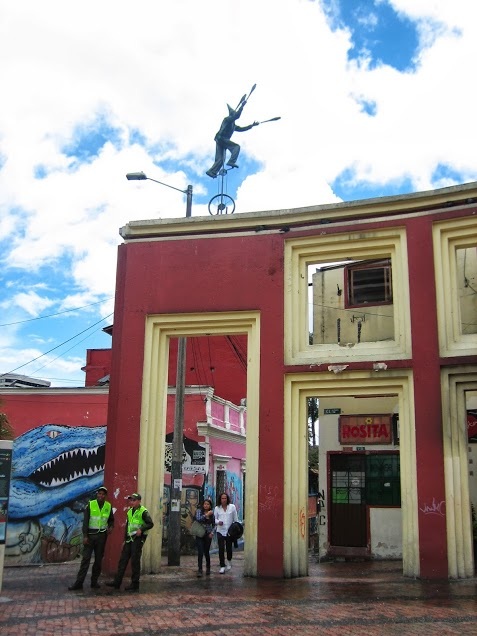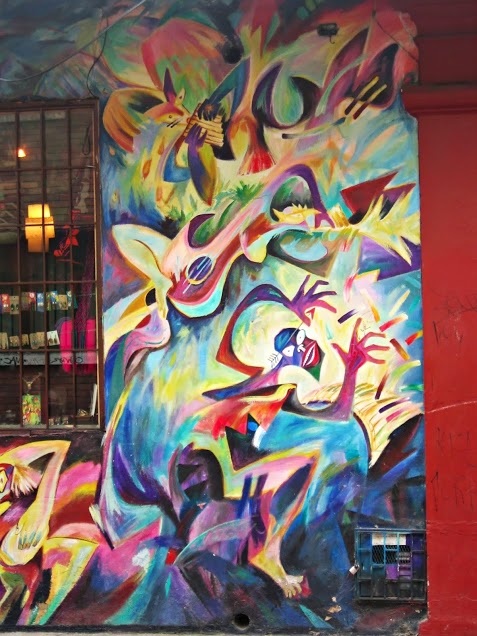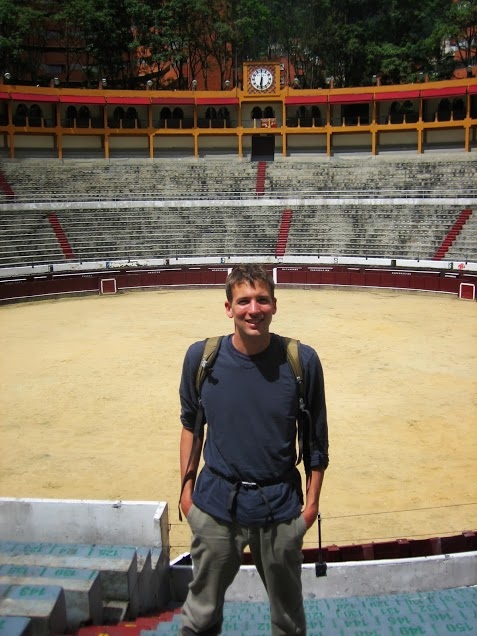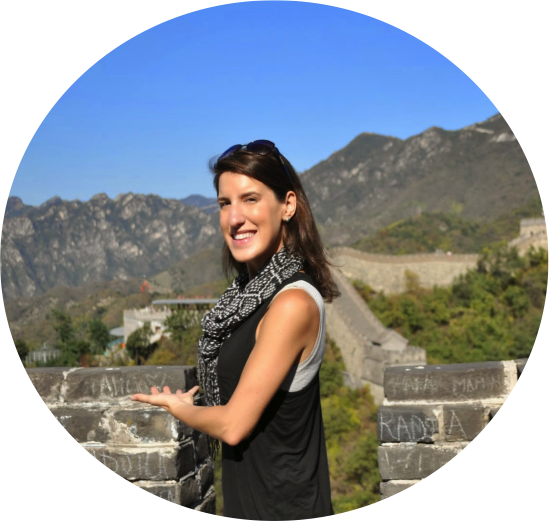Our tour began in La Candelaria and we first rode uphill to the oldest part of Bogota, the Plazoleta del Chorro de Quevedo. Here our tour guide, Jaime, explained that the reason you see so many young police officers all over the city is that all Colombian men must serve two years of compulsory military or police service. Joining the army invariably means eventual run-ins with the FARC, which is very dangerous, so most people choose to join the police force. We next rode our bikes to Bolivar Plaza, the political center of present-day Bogota.
Bolivar Plaza is surrounded by a major cathedral, the justice department and the capitol building, where congress meets. Jaime spent a bit of time discussing the more recent political history of Colombia including the origins of the current political parties and the FARC. This all dates back to the late 1940's. Colombia experienced a period of strong economic growth during World War II, and coming out of the war, there were various political groups vying for control of the government. The leader of the Populist movement, Jorge Eliecer Gaitan, was assassinated during his presidential campaign in 1948, setting off a period of significant political unrest in Colombia, essentially a decade long civil war between the conservatives and liberals known as La Violencia, during which time around 300,000 people were killed. Following the war, the two parties agreed to share power, alternating control of government. The post-Violencia conservative government pursued a policy of commercializing most of the agriculture in the country in order to boost productivity, essentially favoring large corporate agribusiness over local farmers and, in effect, causing many independent farmers to join one of the larger corporate entities. Amidst this climate, the environment was ripe for the communist sympathizers to gain more support from these displaced local farmers in the countryside, and in the early 1960's, the FARC was born.
Since that time, there has been constant fighting between the FARC and the Colombian government, with the FARC vying for control of Colombia'a government, as well as periodically proclaiming certain regions of the country under independent rule of the FARC. Its activities are funded primarily by illegal activities, including taxes on the illicit drug trade and kidnappings/ransoms of hostages. They also commandeer land from local farmers for use in the illicit drug trade, and frequently kill those who don't comply. For this reason, most political entities both inside and outside of Colombia view FARC as a terrorist organization rather than a legitimate political entity. Over the years, FARC's real political objectives have become less clear, and many people now join the FARC simply as a way to make money.
Today, there remain the liberal and conservative parties active in Colombian government, with the liberal party represented by red and the conservatives by blue (opposite of the US). Each party even has its own national soccer team! The FARC, representing an extremist left-wing organization, remains active in certain remote areas of the country, and from time to time, launches attacks against more developed areas including Bogota. There is currently an ongoing negotiation between the government and FARC, with talks being held in Cuba. There is still the perception among many in Colombia that the government is controlled by a small group of elite, wealthy people, and corruption remains a major problem. As an example, Jaime referenced a small bridge in Bogota that took three years to build, rather than three months, as the official in charge of the project is suspected to have pocketed most of the allocated funds for himself. This, he says, is representative of the way things work in Colombia.
Pablo Escobar:
At this point, Jaime also talked about Colombia's struggles with the illicit drug trade, and in particular, the period of time when Pablo Escobar and the Medellin Cartel dominated cocaine trafficking. Escobar was, at one point, one of the wealthiest people in the world. For a brief period, he also had political ambitions and was seeking a seat in Congress, going so far as to offer to repay Colombia's national debt using his personal checkbook. Escobar was also one of the first drug lords to import a personal zoo, bringing in exotic animals from Africa. The zoo served two purposes - as a personal amusement park, and also as a means to dispose of his enemies, whom he would reportedly feed to his zoo animals. Despite the many horrible activities and violence Escobar was responsible for, many of Medellin's poor still view him as something of a local hero, as he would frequently give them houses and cash. Our guide did not see it that way. He described Escobar's death as the day that the nightmare of Colombia ended.
Graffiti or Street Art?
And back to the Plaza...Jaime mentioned that most of the graffiti seen in the photo is related to the frequent political rallies and protests that take place here. Graffiti is present throughout Bogota - much of it viewed as art - and there are even Graffiti tours operating in the city.
From here, we took our bikes to a large, traditional market. This is a huge, covered marketplace full of vendors selling a wide variety of fruits, vegetables, fish, poultry, eggs and meats. We wandered through the market for about 15 minutes and probably saw less than half of it! I think that we would definitely be frequent visitors here if we lived in Bogota!!
Sorry friends, but this next part is going to be a downer. After the market, we rode through an area called Santa Fe, which is the red light district of Bogota. It's the intersection of addiction, poverty and desperation. This was the only time I was really scared - not just because of the men yelling at scantily clad women and transvestites selling themselves outside of dilapidated apartment buildings, or even the the drug addicts and alcoholics nodding off on the dirty sidewalk. I was scared because I didn't see one police officer from the moment we turned down the street that led to this area. Everywhere else in Bogota, you see officers clad in bright yellow vests on every single street corner. Not here. It was as if Bogota decided it wasn't worth sending their officers into this wasteland. In Santa Fe, we were told not take pictures and after seeing it, you would never want to. These are images you want to forget. This part of the tour was incredibly sad, and what made it worse is knowing we only saw two streets of the better part of the slums. While we were only here for 5-10 minutes, it stuck with us and we felt very helpless knowing that it's such a widespread problem that can't easily be fixed.
Bullfighting Controversy:
Bullfighting is popular in Colombia and Bogota has a ring where they hosted fights up until last year. The current mayor banned bullfighting in Bogota because he considers it animal cruelty. Jaime found this very ironic, because it the mayor used to be a member of the terrorist group 19th of April (now called M-19) and apparently didn't have any issues with cruelty as a young man. Jaime said that many support the ban, many are opposed because they enjoy this Spanish tradition, and others oppose because it puts them out of a job. Jaime didn't seem to lean one way or the other, but having studied abroad in Spain, I know this issue is a sensitive one, regardless of which side you are on.
After the tour we were famished so we stopped at Rositas in Plazoleta del Chorro for a delicious meal! It was an odd time so we were the only people there and therefore had the top floor to ourselves, which made for some neat views of La Candelaria.
Since we were in the area, we decided to go to Montserate - the tall mountain that overlooks Bogota. You get there by cable car or funicular located near La Candelaria. The views were spectacular!
One night we met up with our Boston College acquaintance Gary, and his wife Kathleen. We hadn't seen Gary in over 10 years, but luckily he hasn't changed much so it was easy to recognize him! We went to a great little pub near our hotel called the Red Lion. Both Gary and Kathleen have been teaching English in Bogota for about 2 years and the Red Lion is owned by one of the Kathleen's students. We had such a great time catching up and hearing about their lives and experiences in Bogota!
On our last night, we splurged and went to the famous Andres Carne de Res. Although everyone recommended going to the one in Chia, we opted for the one in Bogota which was in walking distance to the hotel. We were going on a Tuesday night and I don't think the one in Chia was open. Everyone one was right - it was a really fun experience! And we got there at 7pm on a Tuesday. I can't even imagine what it's like on a Saturday night! We were welcomed at our table by a band and dancer that resembled some sort of fabulous bird (pictured below). He had both of us dancing within seconds! We now refer to him as the human peacock.






 RSS Feed
RSS Feed
